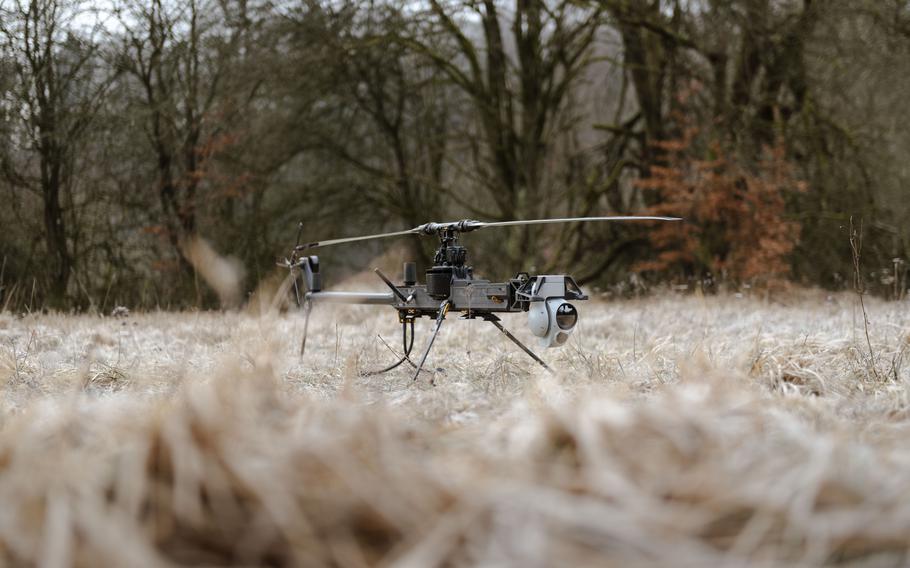
A U.S. Army Ghost reconnaissance drone sits in a field waiting for soldiers to prepare it for flight during an exercise at the Joint Multinational Readiness Center in Hohenfels, Germany, on Feb. 3, 2025. (Lydia Gordon/Stars and Stripes)
HOHENFELS, Germany — Drone pilot Spc. Farouk Muhieddine sat calmly in his concealed foxhole at the Army’s vast training range in rural Bavaria, a laptop open in front of him.
After receiving targeting information Monday from a Ghost-X reconnaissance drone, he simulated striking an opposing force over a mile away with a loitering munition.
“We’ve been getting kills left, right and center without even having to see the enemy,” said Muhieddine, who is assigned to 3rd Brigade, 10th Mountain Division.
Muhieddine works with the Army’s newest unmanned aerial systems, applying tactics of a fighting strategy influenced by lessons learned from the ongoing Russia-Ukraine war.
His lethal unmanned systems platoon, an experimental unit, endured freezing temperatures Monday as they took on an opposing force of soldiers from 1st Battalion, 4th Infantry Regiment, during the Combined Resolve exercise at the Joint Multinational Readiness Center in Hohenfels.
Combined Resolve, which runs until Feb. 16, features 4,000 U.S. and allied soldiers from 16 NATO and European countries.
The monthlong drill is giving Muhieddine and his fellow participants a crash course in the new strategy, which the Army has dubbed “transforming in contact.”
Drones like the Ghost-X and loitering munitions — known as LASSO, or low altitude stalk and strike ordnance — are integral to it.
Last year, the Pentagon signed a $990 million contract to receive an indefinite number of AeroVironment Switchblade-series loitering munitions over the next five years.
The single-use munitions, often referred to as kamikaze drones, are launched from a tube and use a mounted camera to fly to and strike their target. They have a range of up to 25 miles depending on the antenna and can stay airborne for up to 45 minutes, Muhieddine said.
A short distance away, drone maintainer Spc. Layton Waller watched a Ghost-X land like a helicopter on grass just outside the tree line.
The 55-pound reconnaissance drone can be deployed rapidly, is equipped with infrared and can figure out its precise location even when global positioning is down, Waller said.
It can fly 15.5 miles for up to 75 minutes and uses artificial intelligence to help its human operators identify targets, the website of manufacturer Anduril states.
“Two of the biggest progressions (from previous drones are) being able to fly in (poor) weather conditions and how simple the system is to use,” Waller said. “It can be used by anyone in the Army.”
The exercise also has shown the soldiers how to better manage the limitations of the new systems.
On Sunday, one Ghost-X was overused, causing it to malfunction and crash. The drone’s AI target identification is helpful but doesn’t currently stack up to the human eye’s ability to spot targets, Waller said.
The new Army fighting doctrine receiving its baptism in Hohenfels calls for troops to be more mobile, adaptable and technologically savvy.
Tactics include fake command posts, electromagnetic decoys and transport vehicles that help keep troops moving and increase their odds of surviving.
As the action unfolded Monday, Brig. Gen. Steven Carpenter surveyed the troops. Carpenter is in charge of the 7th Army Training Command, the resident operator of the Joint Multinational Readiness Center.
“By fielding a number of new mobility platforms, the Army is trying to equip light-infantry units with the ability to rapidly reposition throughout the battlefield,” he said.
He added: “One of the lessons that we’ve learned from the war in Ukraine is that the battlefield is essentially transparent now in the sense that you can always be seen.”